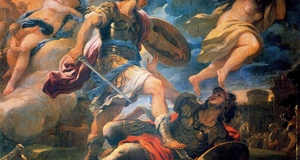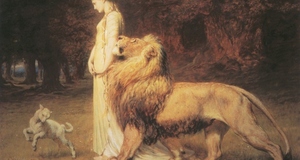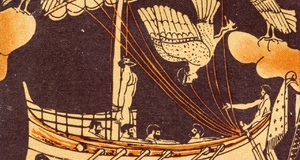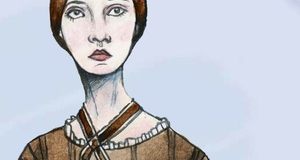The dichotomy between the historical and fictional Dido is the difference between a martyr for chastity and a timeless romantic tragedy. While the unsullied queen may have been a powerful moral example, the impure Dido becomes a timeless inspiration. Her side of the story inspired immediate sympathy; Ovid wrote a collection of fictional responses from the scorned women in mythology called the Heroides, each written as a letter in the lyrical elegiac couplet. The seventh book contains a large letter from Dido to Aeneas.6 Ovid's Dido is increasingly sympathetic; her letter moves from disparaging to reproachful to pathetic at times. She begins by stating that the letter is not meant to win Aeneas back:
Not because I hope that you can be moved by my prayers
Do I speak--I speak them with the gods against me;
But having lost, miserably, my merit and reputation, my virtue
Of body and spirit, to lose words is a small thing
(trans. Hunter, lines 3-6).
Yet Dido's letter is full of intent. She wants to curse Aeneas; she wants to reflect on her mistakes and her impending suicide. She is sarcastic: "Are you determined, Aeneas, to release your promises with your ships," (Ibid, line 9), She wishes a sweeter revenge than her false lover's swift death:
Live, I pray you. Thus I shall destroy you more fully than by death.
Rather, you shall be said to be the cause of my death.
Consider that you are seized--may there be no weight to the omen--
By a fierce storm; what will be in your mind?
Immediately will come the perjury of your false tongue,
And Dido driven to die by Phrygian7 deception
(Ibid, 63-78).
The queen speaks extensively of what she has given up for her foolish love. She tells of the suspicious death of her husband, and her journey to distant soil to found Carthage. She speaks of the wars and ardent suitors that assailed her because she was a foreign woman leading a prosperous city: "I purchase this shore, traitor, which I gave to you. I founded a city, and set down extensive walls."(Ibid, 118-119).
Ovid's Dido even speaks of scandal-the potential that more than one life could be taken up by the flames:
Perhaps also it is a pregnant Dido, evil one, whom you abandon,
And a part of me lies hidden in my body.
The wretched infant will join the fate of the mother,
And you will be the author of the death of your unborn child
(Ibid, 138-143).
Her closing words after this invective diatribe are powerful: "If you are ashamed of me as a wife, then let me be called not bride but hostess; So long as she is yours, Dido will be what you wish." (Ibid, 172-173).
Ovid's Dido is more emotionally unstable than Virgil's. Her letter changes moods frequently and describes an incredibly bitter fallen queen. The example, however, serves to illuminate Virgil's importance. His episode with Dido has changed from a side quest in the greater scheme of Aeneas' epic to a work of art in itself. Many works since have recreated the monarch's internal monologue, fraught with strife and reproach for the supposed hero of the epic. This tradition of sympathy extended well into the late 16th century in musical settings as well as literary interpretation.
The practice of setting Latin classical texts as motets is not uncommon in musical history. The form of the motet was originally derived from liturgical chant accented with secular poetry. The secular text was considered an allegorical elaboration of the themes in the sacred text (Randel, 529). While the motet is generally thought of as a genre sacred to Christianity, Tinctoris' 1495 dictionary of musical terminology states that a motet could be on any subject, though sacred texts were the most common (Randel, 530). Thus, one could make exceptions for secular texts from classical Latin poetry. Fifteenth century education relied on the ancient Roman epics as teaching tools. Albert Seay, a musicology professor at Colorado College, wrote on medieval exposure to classical texts and the use of classical metrics in music. He states:
The study of the three great Golden Age poets (and others as well) remained as one of the strongest parts of the school curriculum, with every student eventually taken through the classics. With the renewed interest in the classics during the fifteenth century and with the beginnings of printing as a way of diffusion of texts, the audience for the Latin classics (and the Greek ones as well) became a wide one indeed... (Seay, 64).
Furthermore, historical sources in Seay show that the memorization of classical poetry was aided by the use of song. Seay documents the symbiosis of music and Latin education:
In teaching the classics, music was called into service as a valuable instructional aid. Instead of merely reciting those sections of the Aeneid that one had learned by straight memorization, some devised simple ways of singing them, so that they would be easier to recall (Ibid, 64).
In the late 15th century composers would have been indoctrinated into the association of music with classical Latin. Tinctoris makes mention of Virgil, Ovid, or Horace in all twenty chapters of his treatise Complex of the Effects of Music (IBID, 64). Perhaps it was not such a stretch of the imagination for a composer to utilize these highly elevated texts in pursuit of artistic expression.
Dido became a popular subject in Renaissance music. The text that gained the greatest prominence was derived from the queen's final speech in book four of the Aeneid. While the speech is rife with inflammatory passages and stately language, the four lines that were singled out for musical setting by Josquin des Prez became emblematic of Dido's entire saga. The original Latin is given above.Continued on Next Page »
Crane, Gregory R. (ed.) The Perseus Project, http://www.perseus.tufts.edu, February, 2008.
Dryden, John, translated. The Aeneid. http://www.perseus.tufts.edu, February, 2008.
Edgeworth, R.J. "The Death of Dido," The Classical Journal, 72.2 (Dec. 1976-Jan 1970): 129-133.
Guentner, Francis J. "Dulces exuviae in Sixteenth Century Music," The Classical Journal, 68.1 (Oct.-Nov., 1972): 62-67.
Holford-Strevens, Leofranc. "'Her Eyes Became Two Spouts': Classical Antecedents of Renaissance Laments," Early Music 27.3 , Laments (August 1999): 379-393.
Hollander, Robert. Expanded version of the article "Virgil." Dante Encyclopedia. Ed. Richard Lansing. New York: Garland Publishing, Inc, 2000.
Huelgas Ensemble dir. Paul van Nevel. Josquin des Prez. "Dulces Exuviae." Le Chant de Virgile. Harmonia Mundi Fr., 2001.
Hunter, James m. "Ovid Heroides VII" An Ongoing Translation of Ovid's Heroides. 31 October 2008.
MacKail, J.W. (translated) The Eclogues of Vergil. http://www.sacredtexts.com/cla/virgil/ecl/index.htm, March, 2008. "Motet." The Harvard Dictionary of Music. Ed. Don Michael Randel. 4th ed. Cambridge, Massachusetts and London,
England: The Belknap Press of Harvard University Press, 2003.
MOTET online database. Dr. Jennifer Thomas. Revised May 10th, 2008. Univeristy of Florida. May 18th, 2008. http:// www.arts.ufl.edu/motet/default.asp
"Motet." The Oxford Dictionary of Music, 2nd ed. rev. Ed. Michael Kennedy. Oxford Music Online. 16 Mar. 2009 .
Ovid. "Epistulae Heroidum: VII Dido Aeneae." The Latin Library. Posted by David J. Califf from an original edition. 31 October 2008.
Schmalfeldt, Janet. "In Search of Dido," The Journal of Musicology, 18.4 (Autumn 2001): 584-615. Seay, Albert. "Classical Metrics and Medieval Music," The Bulletin of the Rocky Mountain Modern Language Association, 23.2 (June 1969): 59-67.
Strunk, W. Oliver. "Virgil in Music," The Musical Quarterly, 16.4 (October 1930): 482-497.
Thomas, Jennifer. "Motet Online Database." Dulces Exuviae. 10 May 2008. University of Florida. 2 November 2008.
Thompson, James Westfall. "Vergil in Mediaeval Culture," The American Journal of Theology, 10.4 (October 1906): 648662.
Townend, G.B. "Changing Views of Virgil's Greatness," The Classical Journal, 56.2 (November 1960): 67-77. Williams, Theodore C, translated. The Aeneid. http://www.perseus.tufts.edu, February 2008. Wills, Garry, trans. The Confessions of St. Augustine. New York: Penguin Classics Deluxe Edition, 2006.
Endnotes
- Virgil, Aeneid, 4:651-654, trans. John Dryden. For translations of the passages immediately surrounding the dulces exuviae text, see Appendix One.
- A form of short unaccompanied choral composition...in use from 13th to early 16th cents. In 13th, 14th, and 15th cents. the motet was exclusively sacred and was based on a pre-existing melody and set of words to which other melodies and words were added in counterpoint. Oxford.
- See appendix two for a listing of motet settings of the Dulces exuviae
- Edgeworth quotes directly from Horace White's eloquent translation of Appian.: Appian VIII.xix. 13 1 , trans. Horace White, I (London 1912 [Loeb Classical Library]) 635-637
- Edgeworth draws a symbolic connection between the fiery deaths of the two queens: "The detail of the blazing pyre, which seemed to serve no purpose in the poem, has been added in order to suggest the blazing fall of Carthage."
- See Appendix Four for a full translation of Heroides VII by James m. Hunter.
- Phrygia was a kingdom in ancient Anatolia, and is used as a descriptive epithet for Aeneas.
- Dactylic hexameter is a metrical scheme utilized in Greek and Roman epic poetry. It consists of lines with six metrical feet broken up into dactyls (a long syllable followed by either another long syllable or two short ones).
- See appendix two for a listing of all the occurrences of the Dulces Exuviae text.
- Any melodic or harmonic progression which has come to possess a conventional association with the ending of a comp., a section, or a phrase. Oxford.
- Included as Appendix Three. All references to measure numbers are to this edition.
- Specifically in Mabriano de Orto and an Anonymous setting from the Bernard Thomas edition
- A group of more than five or six notes sung to a single syllable. Oxford.
- Simultaneously sounding musical lines according to a system of rules. Oxford.
- An Eclogue is a lyrical poetic form which typically contains pastoral imagery.
- When Constantine the Great in 324 A.D. publicly declared the establishment of Christianity as the religion of the Empire, he quoted the Fourth Eclogue as an important testimony to the recognition of the new faith by Rome's greatest poet. This gave Virgil a posthumous reputation as a sort of potential Christian before his time, to be classed in a way with the great Hebrew prophets, though somehow possessing a fuller understanding of the Christian spirit than any of them. Townend, 71,
- See Appendix Three for a full translation of the Eclogue by J.W. MacHail
- Schmalfeldt led the way to the original quotation: Perhaps the most notable example is to be found in the Confessions of St. Augustine (354-430 A.D.), where the early Church father looks back on his school days in Carthage and reproaches himself for having wept then over the death of Virgil's Dido when he should have been weeping over his own youthful alienation from God.
- Or, in Schmalfeldt's opinion on page 588, Dido is not a mirror but a foil for Aeneas. She gives a chart that highlights the pair's opposition. For example, whereas Aeneas is "driven by duty and honor-as public, supra-personal virtues," Dido is "driven by love-a private, individual emotion, thus, potentially subversive and socially disruptive." Or, Aeneas is "rational and strives for order" while Dido "becomes irrational and creates chaos."




















